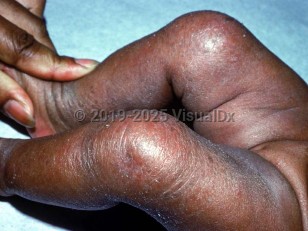Essential fatty acid deficiency in Infant/Neonate
Alerts and Notices
Important News & Links
Synopsis

Essential fatty acids, such as linoleic, linolenic, and arachidonic acids, cannot be produced by the body; therefore, they must be obtained through food. They can be found in vegetable oils, plant seeds, green leafy vegetables, soybeans, meats, eggs, and fish. They are important as a major constituent of the stratum corneum, helping to maintain the skin barrier. They also serve as substrates necessary for the synthesis of other fatty acids, including those required for the synthesis of prostaglandins and leukotrienes, which play important roles in inflammation.
Essential fatty acid deficiency is rare, as almost all diets contain adequate amounts. It can be caused by gastrointestinal disorders or surgeries resulting in fat malabsorption, long-term parenteral nutrition without lipid supplementation, extremely low-fat diets, anorexia nervosa, alcohol use disorder, cystic fibrosis, and nephrotic syndrome. In most instances, this deficiency is associated with other nutritional deficiencies, such as kwashiorkor and marasmus. Because of their increased metabolic needs, infants – especially premature infants – are also at risk. Infants may be fed a diet low in essential fatty acids if given cow's milk.
The diagnosis is made based on clinical and laboratory features. The skin appears dry, scaly, and leathery with erythema. Intertriginous erosions, alopecia, hypopigmented hair, and petechiae may also be seen. Systemic features include failure to thrive, growth retardation, poor wound healing, thrombocytopenia, impaired reproductive health, abnormal liver and kidney function, increased susceptibility to infections, and neurologic damage.
The diagnosis can be made by measuring plasma linoleic, linolenic, arachidonic, and icosatrienoic acids.
The prognosis depends on the severity and coexistence of other nutritional deficiencies.
Essential fatty acid deficiency is rare, as almost all diets contain adequate amounts. It can be caused by gastrointestinal disorders or surgeries resulting in fat malabsorption, long-term parenteral nutrition without lipid supplementation, extremely low-fat diets, anorexia nervosa, alcohol use disorder, cystic fibrosis, and nephrotic syndrome. In most instances, this deficiency is associated with other nutritional deficiencies, such as kwashiorkor and marasmus. Because of their increased metabolic needs, infants – especially premature infants – are also at risk. Infants may be fed a diet low in essential fatty acids if given cow's milk.
The diagnosis is made based on clinical and laboratory features. The skin appears dry, scaly, and leathery with erythema. Intertriginous erosions, alopecia, hypopigmented hair, and petechiae may also be seen. Systemic features include failure to thrive, growth retardation, poor wound healing, thrombocytopenia, impaired reproductive health, abnormal liver and kidney function, increased susceptibility to infections, and neurologic damage.
The diagnosis can be made by measuring plasma linoleic, linolenic, arachidonic, and icosatrienoic acids.
The prognosis depends on the severity and coexistence of other nutritional deficiencies.
Codes
ICD10CM:
E71.30 – Disorder of fatty-acid metabolism, unspecified
SNOMEDCT:
238114000 – Essential fatty acid deficiency
E71.30 – Disorder of fatty-acid metabolism, unspecified
SNOMEDCT:
238114000 – Essential fatty acid deficiency
Look For
Subscription Required
Diagnostic Pearls
Subscription Required
Differential Diagnosis & Pitfalls

To perform a comparison, select diagnoses from the classic differential
Subscription Required
Best Tests
Subscription Required
Management Pearls
Subscription Required
Therapy
Subscription Required
References
Subscription Required
Last Updated:06/07/2018
Essential fatty acid deficiency in Infant/Neonate

